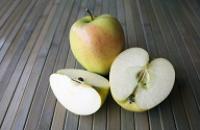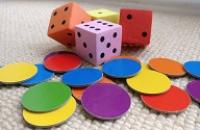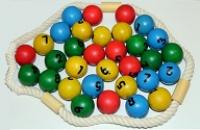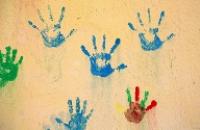




Children often enjoy counting for their own enjoyment, recounting things they have counted before, arranging or lining up objects, filling and emptying containers of objects, making choices about what they like to count and having favourites.
Adults could demonstrate counting rhythmically, using different ways to keep track when counting objects, pausing to say how many they have counted so far, putting objects into groups and representing amounts using drawings or symbols.
The Activity
In pairs, children choose a collection of objects which they would like to count (from a range of collections in boxes or jars). They decide together how they will count their collection and may choose resources to help them (such as pots or trays to count into or to group objects for counting). The children count their collection and then record their count, by drawing or mathematical mark making (using numerals alongside these if they wish). If possible, children should work in pairs to select, count and record but children might work alone or with an adult, as appropriate.
Encouraging mathematical thinking and reasoning:
Describing
How many are there? Show me how you counted them. How did you keep track of which ones had been counted?
Reasoning
How do you know you have 12?
Why did you choose to count them this way? Can you count them a different way?
Is there another collection with the same number?
Opening Out
Use trays, mats or images with two (or more) sections and place the objects into the sections. Talk about composition (the numbers that make up the total). Move one or more objects between sections to see how that changes the numbers.
Recording
Use large sheets of blank paper for children to choose how to record their count. Some children may choose to draw around the objects, some may draw pictures and some may use their own symbols (such as lines or circles). Provide numerals for children to use as labels or refer to.
The Mathematical Journey
Number:
- saying the number sequence (teen numbers, especially 13, are harder)
- one-to-one correspondence when counting (assigning one number word to each object)
- counting to find ‘how many’ (cardinality)
- subitising (instantly recognising how many without counting) small collections of objects in familiar and perhaps unfamiliar arrangements.
- subitising small collections of objects within a larger group of objects, e.g. seeing three within five or making groups of 3s without counting 3 in each group
- counting groups of objects in 2s, 5s or 10s (for older children)
Pattern:
- arranging objects into familiar patterns to aid counting (e.g. domino patterns, Numicon patterns or ten frame pattern)
Development and Variation
- Store all resources in a counting library which can be accessed within the continuous provision. Decorate the area with interesting images for counting and include number tracks, hundred squares, rulers and calculators.
- Parents can help children to make their own counting collections at home, bringing their collections to the setting to share with other children. Providing bags or jars as well as ideas for what to collect (e.g. bottle tops, pebbles, shells) can help.
- Create large outdoor collections using buckets.
- Take children on a walk to the local woods to create natural collections.
- Make themed collections related to festivals or seasons. You might make a new collection from each educational visit that you take the children on, building up a counting library of memories to enjoy counting again and again.
- Compare two or more collections. Which is the largest/smallest number of objects? Lining up or grouping the objects alongside each other to show the difference.
- Arrange collections in order of size or create two shelves, one for odd numbered and one for even numbered collections.
- Play games with the objects, for example ‘ten nice things’, ‘nim’ or ‘who has more’?
- Discuss the zero collection (empty box or jar).
Resources

- Boxes or jars containing different collections of things to count (e.g. twigs, matchsticks, lolly sticks, jewels, spoons, feathers, pegs, pom poms, bottle tops, curtain rings, pebbles, tiles, fabric squares, conkers, shells, plastic figures, cotton reels, corks, beads). The collections may be labelled or colour-coded so the smaller and larger collections are apparent (e.g. 0-10, 11-20, 20-30, 30+).
- Containers to count into, out of or for grouping whilst counting (e.g. trays, bowls, boxes, bags, egg boxes, ice cube trays, muffin trays, place mats, 5 or 10 frame cards/trays).
- Large sheets of blank paper for drawing or representing how the collection have been counted.
- Wooden or plastic numerals or number cards to label the collection with the total.
Download a PDF of this resource.
Acknowledgement: Cath Gripton

